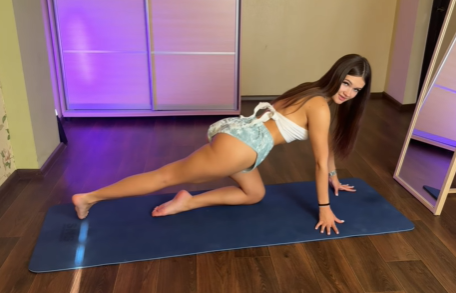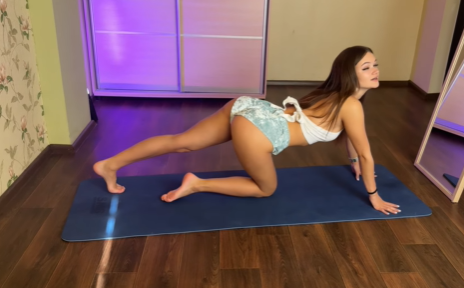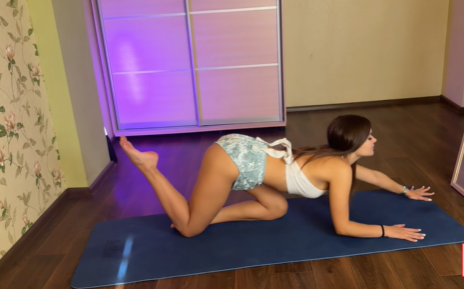
Developing flexibility is one of the best gifts you can give your body. It improves mobility, reduces pain, enhances posture, and allows you to move through daily life with greater ease. A flexibility daily routine doesn’t just make your body limber — it helps your mind unwind, lowers stress levels, and increases energy. Whether you’re an athlete, yoga lover, office worker, or simply someone who wants to move better, adding flexibility training into your everyday schedule can bring lasting benefits.
This 1000-word guide will take you through a complete daily flexibility routine, focusing on gentle, mindful movements that loosen tight muscles, improve range of motion, and restore harmony between body and mind.
Why Flexibility Matters
Flexibility isn’t just about doing splits or fancy yoga poses. It’s about creating balance and freedom within your body. Tight muscles can cause discomfort, limit mobility, and even contribute to injuries. A flexible body means your muscles and joints work efficiently together. You’ll move more gracefully, experience less stiffness, and recover faster from physical activity.
But there’s more — flexibility also improves circulation and supports mental well-being. The slow, intentional movements in stretching release tension, activate the parasympathetic nervous system, and calm your mind. It’s a daily reset that brings you into the present moment.
Morning Flexibility Routine (10–15 minutes)

Start your day by awakening your muscles and joints. Morning stretching helps combat stiffness from sleep and sets the tone for a balanced, energized day.
1. Neck and Shoulder Rolls (1 minute)
Begin seated or standing tall. Inhale as you roll your shoulders up toward your ears, then exhale as you roll them back and down. Repeat this motion 10 times. Then gently roll your head from side to side, allowing tension to melt away from your neck.
2. Cat-Cow Stretch (1–2 minutes)
Come onto your hands and knees. Inhale, arch your spine, and lift your chest and tailbone toward the ceiling (Cow). Exhale, round your spine, and tuck your chin toward your chest (Cat). Move slowly and rhythmically, syncing breath with movement to awaken your spine.
3. Standing Forward Fold (1–2 minutes)
Stand tall, feet hip-width apart. Inhale to lengthen your spine, then exhale to fold forward, letting your head and arms hang heavy. Bend your knees slightly if needed. Feel the stretch through your hamstrings, lower back, and neck. Take slow breaths and release tension.
4. Side Stretch (1 minute per side)
Stand tall with feet shoulder-width apart. Raise your left arm overhead and gently lean to the right, keeping your chest open. Feel the stretch along your side body and ribs. Switch sides and repeat.
5. Hip Circles (1–2 minutes)
Place your hands on your hips and slowly draw large circles with your hips, first clockwise, then counterclockwise. This loosens the lower back and hips, perfect for people who sit for long hours.
6. Calf and Ankle Mobility (2 minutes)
Shift your weight into one leg and rotate your ankle slowly in circles. Switch legs. Then, stand facing a wall and press your heel into the floor for a deep calf stretch.
This morning series not only wakes up your body but also energizes your mind — helping you start the day with flow and positivity.
Midday Movement Break (10 minutes)

After sitting at a desk or working for several hours, muscles can become tight and fatigued. A short midday flexibility break refreshes circulation and helps prevent soreness.
1. Seated Spinal Twist (1 minute per side)
Sit tall in your chair or on the floor. Place your right hand behind you and your left hand on your right knee. Inhale to lengthen your spine, then exhale to twist gently to the right. Hold for several breaths, then switch sides.
2. Shoulder and Chest Opener (2 minutes)
Clasp your hands behind your back and straighten your arms as you gently lift your chest. This opens the front of your shoulders and counters the rounded posture caused by long hours of sitting.
3. Hamstring Stretch (2 minutes)
Stand and place one foot on a chair or low surface. Keep your spine straight as you hinge forward slightly over your extended leg. Breathe deeply and feel the stretch along the back of your thigh.
4. Seated Forward Fold (2 minutes)
Sit with legs extended in front of you. Inhale to lengthen your spine; exhale and fold forward, reaching toward your toes. Keep your breath smooth and your body relaxed.
5. Wrist and Finger Stretch (2 minutes)
Gently stretch your wrists and fingers, especially if you use a computer or phone often. Extend one arm forward, palm facing up, and pull back gently on your fingers with the opposite hand. Switch sides.
These quick movements release mid-day tension, enhance focus, and help maintain productivity for the rest of your day.
Evening Flexibility Flow (15–20 minutes)

Evenings are the perfect time to dive into a deeper stretch routine. Your body is warm from the day’s activities, and a calming session helps you unwind before bed.
1. Child’s Pose (2–3 minutes)
Kneel on the floor, big toes touching, knees apart. Sit back on your heels and fold forward, extending your arms in front of you. Rest your forehead on the mat and take slow breaths. This pose gently stretches your hips, back, and shoulders while calming your mind.
2. Low Lunge Stretch (2 minutes per side)
Step your right foot forward into a lunge, with your back knee resting on the mat. Sink your hips forward, keeping your chest lifted. This deep stretch opens your hip flexors, which often become tight from sitting. Switch sides after one minute.
3. Seated Butterfly Stretch (3 minutes)
Sit tall, bring the soles of your feet together, and let your knees fall open. Hold your feet with your hands, and gently press your knees toward the floor. Breathe deeply into your inner thighs.
4. Supine Twist (2 minutes per side)
Lie on your back, draw your right knee into your chest, and guide it across your body while extending your right arm to the side. Look toward your right hand for a gentle spinal twist. Switch sides after a few breaths.
5. Reclined Hamstring Stretch (2 minutes per side)
Lie on your back and extend one leg toward the ceiling. Hold behind your thigh or calf and breathe deeply, keeping the other leg relaxed on the floor. Switch legs.
6. Happy Baby Pose (2–3 minutes)
Hold the outsides of your feet, bend your knees, and draw them toward your chest. Gently rock side to side, massaging your lower back and releasing tension.
7. Legs-Up-the-Wall (3–5 minutes)
Lie on your back and rest your legs up against a wall. Allow your arms to relax at your sides. This restorative inversion encourages blood flow, reduces swelling in the legs, and promotes deep relaxation. Close your eyes and breathe slowly.
This evening flow not only enhances flexibility but also encourages emotional release and tranquility, preparing you for restful sleep.
Tips for Success
- Consistency is key.
Practice flexibility daily, even if it’s just 10 minutes. Regularity matters more than intensity. - Breathe deeply.
Never hold your breath while stretching. Deep breathing enhances oxygen flow and helps your muscles relax. - Move slowly and mindfully.
Avoid bouncing or forcing a stretch. Allow your body to ease gradually into each position. - Listen to your body.
Flexibility improves with patience. Pain is a sign to back off — stretching should feel relieving, not painful. - Hydrate and stay warm.
Water and gentle movement keep your muscles supple and reduce the risk of injury.
Conclusion
A flexibility daily routine is more than a physical practice — it’s a mindful ritual that connects you to your body and your breath. Each stretch is a reminder to slow down, release what you no longer need, and create space for ease and flow. Over time, you’ll notice not only physical improvements — better posture, greater mobility, fewer aches — but also a sense of inner calm and balance.
By dedicating a few minutes each day to stretch, breathe, and reconnect, you cultivate both strength and serenity — the perfect blend for a flexible body and a flexible mind.


